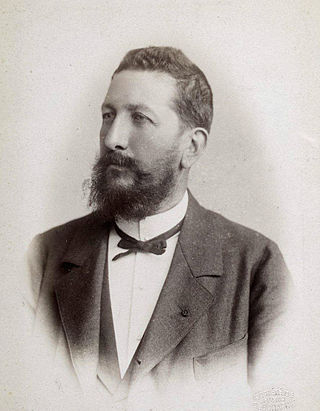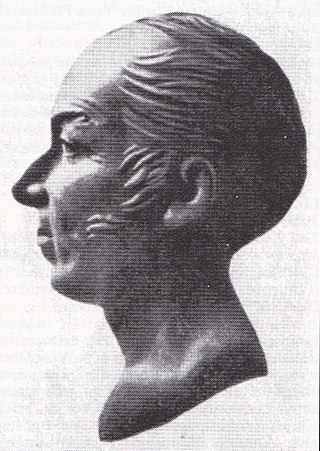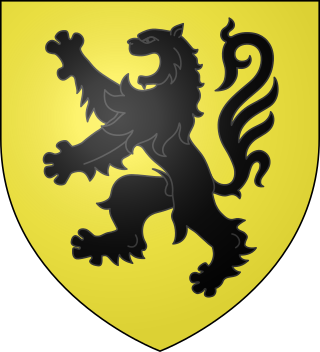Related Research Articles

Corentin Cariou is a station of the Paris Métro.

Marie-Louis-Antoine-Gaston Boissier, French classical scholar, and secretary of the Académie française, was born at Nîmes.

Morlaix is a commune in the Finistère department of Brittany in northwestern France. It is a sub-prefecture of the department.

Penmarch is a commune in the Finistère department of Brittany, northwestern France. It lies 18 km south-west of Quimper by road.
The Bugul Noz is a nocturnal fairy or bogeyman-like being in Breton folklore, from Morbihan, Brittany.

Le Conquet is a commune in the Finistère department of Brittany in northwestern France. This is the westernmost town of mainland France. Only three island towns—Ouessant, Île-Molène and Ile de Sein—are farther west.

Ernest Chantre was a prominent French archaeologist and anthropologist.

Montricoux is a commune in the Tarn-et-Garonne department in the Occitanie region in southern France. It is located along the banks of the Aveyron, between Nègrepelisse and Bruniquel. The written history of the commune dates back to the eighth century. The Château de Montricoux, built by the Knights Templar, now houses the Marcel-Lenoir Museum, which preserves 130 drawings, pastels, watercolors, oils, and frescoes by this artist, a resident of the town.
Alexandre-Évariste Fragonard was a French painter and sculptor in the troubadour style. He received his first training from his father and drew from him his piquant subjects and great facility, perfecting them under Jacques-Louis David. His parents were Jean-Honoré Fragonard and Marie-Anne Fragonard.

The Abbey of Saint-Mathieu de Fine-Terre is a former Breton monastery, whose ruins are found in the territory of what is now the commune of Plougonvelin on Pointe Saint-Mathieu, in the département of Finistère. The Abbey gives the cape its name. It was dedicated to Saint Matthew the Evangelist, whose skull it housed. It was a Benedictine abbey, and was revived and reformed by the Maurists in the mid-17th century.

Serge Duigou is a French historian, specialising in the history of Brittany. His work focuses on Breton maritime history, the women's place in the Breton society, the links between Brittany and modernity, the migratory movements from and to Brittany, the Breton popular revolts. His numerous conferences aim to make Breton history known to as many people as possible.

Louis-Marie de Carné, comte de Carné was a French politician, journalist and historian.

Jean François Marie Le Gonidec de Kerdaniel was a Breton grammarian who codified the Breton language.

Saint Edeyrn was a pre-congregational saint of Wales, related to Vortigern and the royal house of Powys and the brother of Saint Aerdeyrn and Elldeyrn. Edeyrn is the patron saint of Lannédern in France and Llanedeyrn in Wales, where he founded a monastery of over 300 people.

The Lordship of Léon, later Principality of Léon was a former Breton fief located in the Léon province, in north-western Brittany, which corresponds roughly to the French département Finistère. This lordship was created after the Viscounty of Léon was divided into a viscounty and the lordship at the end of the 12th century. The lordship of Léon was a large fief made of about sixty parishes and trèves. The estates of the lordship are located around the valley of the Élorn river, the town of Landerneau and the castle of La Roche-Maurice. The lordship was initially held by the junior branch of the Viscounts of Léon, which was founded by Harvey I. After Harvey VIII died without issue, the fief was inherited by the Viscounts of Rohan. In the middle of the 16th century the fief became known as "Principality of Léon". Landerneau, Landivisiau, Daoulas, Coat-Méal, Penzé and La Roche-Maurice were the seats of the jurisdictions of this huge Breton lordship.

Herve IV of Léon was the eldest son of Harvey III of Léon and his wife, Margaret of Châteauneuf.
Guihomar II de Léon was a Viscount of Léon. He is said to have succeeded his grandfather Guihomar I.
Guihomar VI of Léon was a Viscount of Léon, son of Conan I.
Pierre-Claude Haudeneau de Breugnon was a French Navy officer.
References
- 1 2 "SAF - Bulletin 1880 - Société archéologique du Finistère". societe-archeologique.du-finistere.org. Retrieved 2024-10-01.
- ↑ Guennec, Louis Le (1984). Histoire de Quimper Corentin et son canton (in French). Les Amis de Louis Le Guennec. p. 266.